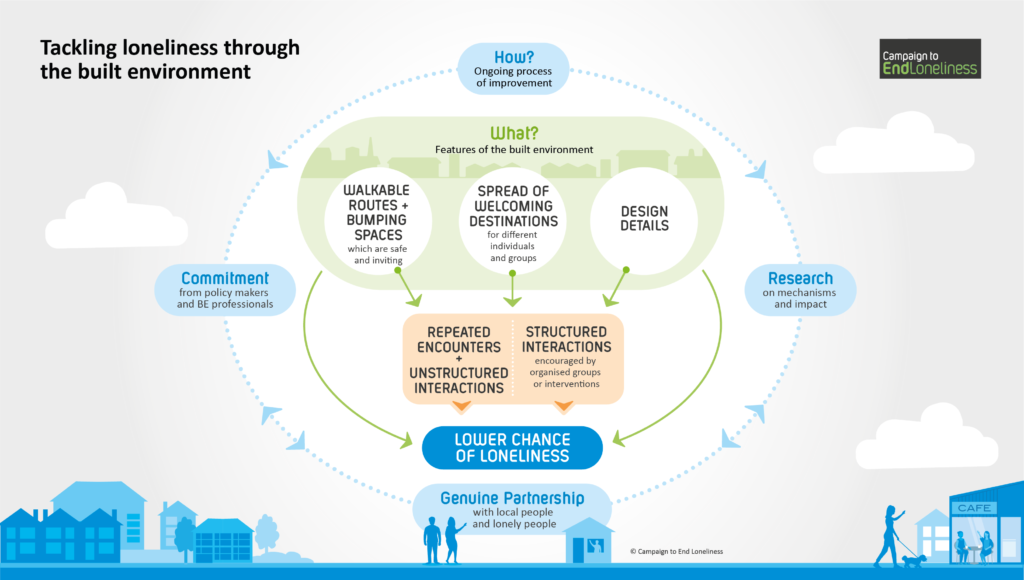Make our future neighbourhoods less lonely places on World Cities Day
With new figures showing 3.8 million people in Britain are now chronically lonely, the design of our neighbourhoods can play an important role in tackling loneliness and helping people to connect, according to the Campaign to End Loneliness which published a new report Tackling Loneliness through the built environment today.
This report sets out why the built environment matters for loneliness, what features make a difference to our experience and how this can be achieved.

The report found that the way we plan and design our built environment needs to encourage different kinds of interaction – we need bumping spaces like benches where we might see neighbours or acquaintances – so called ‘weak ties’. Alongside this, we also need places for the creation of ‘strong ties’ where we develop and maintain real friendships, for example at community groups and activities. A ‘less lonely’ neighbourhood needs to have the right collection of buildings and friendly shared places which are liked by residents and are, therefore, comfortable to use and will foster encounters with others’.
Robin Hewings, Programme Director of the Campaign to End Loneliness said:
“Loneliness is one of the biggest issues we face as a society, and has a massive impact on our overall health and mental wellbeing. New figures show that the number of people who are chronically lonely remains high after the pandemic. So we need to do everything we can, and that includes making our neighbourhoods less lonely.
“Today is World Cities Day and addressing loneliness needs to be prioritised as a matter of course when changes are made to the local built environment. This priority needs to be built into formal regulation through the national planning policy framework and especially through local strategic development plans. Alongside this, training and support is needed for national and local decision makers as well as planners, architects, housing associations and construction companies to understand the impact of loneliness and their power to make change.
“We believe that this report is about beginning the conversation, and building on the expertise that we know exists in some areas on how to build less lonely neighbourhoods.
The Campaign has drawn on a series of events held over the summer involving designers, architects and planners to make a series of recommendations on how to make our neighbourhoods less lonely.
Recommendations include
Protect and create less lonely places
Identify, protect and create attractive, friendly built environments, green spaces with safe, navigable walking routes to enable access to them. These should be designed to support the development of both weak and strong ties for people of different genders, ages, with physical and mental health problems, who are members of ethnic and sexual minority groups, and of varying socio-economic status.
Involve local people and make this an expected part of built environment practice and policy making
Facilitate local people, including lonely people and people at risk of loneliness, to inform and contribute to the process of change and encourage an expectation that the protection and creation of less lonely built environments is prioritised among the public. And, via training, regulation and examples of good practice, that the issue becomes a standard part of thinking and practice for powerful stakeholders: built environment policy-makers and professionals.
Connect this work to other local improvements which address loneliness
Connect work to create a less lonely built environment in an area to improvements in housing, transport, employment, education, health, culture and leisure which can also impact on loneliness.
Strengthen the evidence
Undertake new research, as recommended by the DCMS Tackling Loneliness Review of Evidence, to strengthen understanding of the extent and mechanisms of connection between specific types of place or aspects of place-based interventions and reductions in loneliness, so informing improved design of the built environment.
The Campaign will be continuing to bring together experts across the many different disciplines and areas in order to ensure tackling loneliness is an important aspect of any changes to our built environment.
Notes to editors
- The Campaign to End Loneliness recently carried out an analysis of regular Office for National Statistics and found for the period May to August 2022, 3.8 million people would describe themselves as chronically lonely or feeling lonely all the time. Analysis of the data was carried in September 2022 to responses from ONS Opinions and Lifestyle Survey
- Two seminars were held over the summer of 2022 involving more than 100 representatives from various organisations involved in planning the built environment.
- The Campaign to End Loneliness believes that people of all ages need connections that matter.There are nine million lonely people in the UK who lack the friendship and support we all need. Our vision is that everyone can live a life free from chronic loneliness.We’ve been experts in the field of loneliness and connection since 2011. We share research, evidence and knowledge with thousands of other organisations and the public to make a difference to people’s lives.We inspire everyone to connect and bring communities together across the UK.
- World Cities Day is organised by the United Nations and traditionally brings the Urban October to a close. The theme this year is to Act Local, Go Global.



